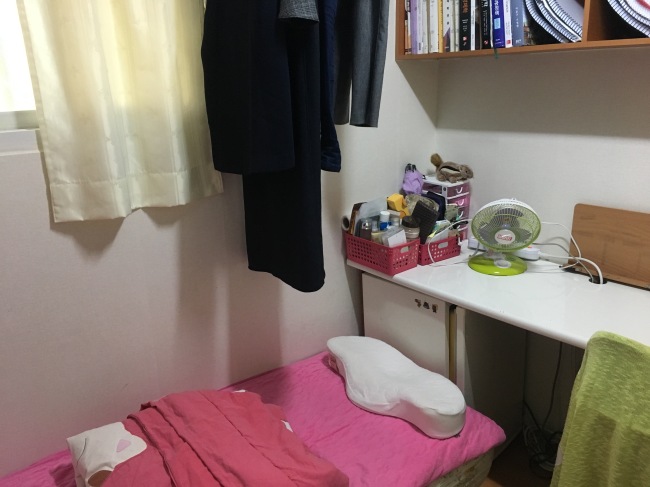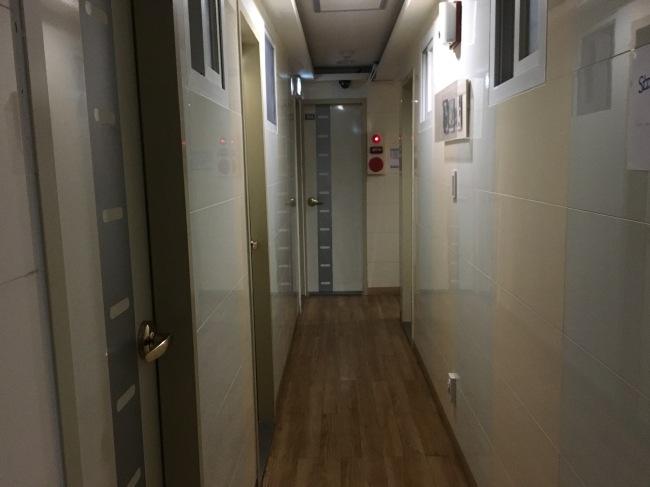[Feature] Gosiwon, modern time refuge for house poor
By Kim Da-solPublished : Sept. 24, 2017 - 15:44
Park Ye-in’s home since March has been a “gosiwon” in Sinchon, a tiny one-room unit in a share house. But she doesn’t usually tell acquaintances where she lives.
“My friends gave me a mixed look of pity and concern when I said I live in a gosiwon,” Park, 22, told The Korea Herald.
“My friends gave me a mixed look of pity and concern when I said I live in a gosiwon,” Park, 22, told The Korea Herald.

Gosiwon are a form of low-cost, cocoon-like accommodation, usually larger rooms divided by thin walls and makeshift doors. Rooms are rented on a monthly basis, and are the cheapest and most flexible form of housing in a country where better options almost always require handsome deposits.
Rooms are as tiny as 3.5 square meters and furnished with a desk, bookshelf and bed. If you are lucky, you get a small refrigerator in the room. But unless you pay for the luxury of a private shower or toilet, you will have to share one with up to 40 other tenants.
“But you know, living in gosiwon should not be something frowned upon by others, because it may be someone’s last resort to get a place to live,” said Park who attends a university in Sinchon.
She is one of 1.3 million young Koreans who live in gosiwon units, basement rooms or makeshift rooftop houses.
Park said there are some perks living in a gosiwon than in a university dormitory, although she ended up in a gosiwon because of a failure to apply in time for the dorm last semester.
“There are some benefits. The (gosiwon) rooms are cheaper and I do not have a curfew.”
Gosiwon rooms generally cost 300,000 won ($260) a month and come with a shared kitchen with complimentary rice and kimchi, although the food is often poor quality.
“I do not eat the rice. Chinese rice is not delicious nor of good quality,” Park said, adding that she normally goes to a convenience store on the first floor to buy something to eat.
Park’s room, which does not have a window, costs 200,000 won a month. The monthly rent goes up to 500,000 won for a room with a private bathroom and a window.
“I wanted to save money for the next semester. It’s OK to live here even though I can clearly hear the man living next door fart and burp through the thin wall.”

Gosiwon originally took off as a distraction-free housing option for students preparing for exams to become public servants and legal practitioners.
Amid soaring housing prices here, however, gosiwon now function as living spaces for ordinary students, college graduates, or people on a tight budget who can’t afford to rent a house with a big deposit amount.
Industry data shows that housing prices in major metropolitan cities continue to soar. Prices of homes in Seoul apartment complexes rose to 5.89 million won per square meter as of June.
Even those who make it onto the property ladder can find themselves stuck. In Seoul and the surrounding area, 4 in 10 homeowners under 35 are house poor, according to Statistics Korea last year, meaning the cost of housing left them without enough money to meet the basic cost of living.
In recent years, the popularity of gosiwon as living spaces has grown rapidly in areas near schools as well as office-packed areas in Seoul.
“Not only students, but low-wage workers began seeking refuge in various forms of gosiwon,” said Hwang Kyu-seok, head of the Korean Gosiwon Society.
“Even areas like Sillim or Noryangjin -- districts where academies for aspiring civil servants are located -- are seeing more nonstudent tenants than before,” he added.
According to government data, there are at least 12,000 registered gosiwon across the country. About 7,000 of them are in Seoul.
Due to their affordable prices, gosiwon have become a refuge for society’s most vulnerable, such as migrant workers, low-income earners and seniors with no family to rely on. Some of them die in their rooms and go unnoticed for weeks.
In June, a man in his 50s was found dead in a gosiwon in Busan. It was reported that he had experienced economic hardship and that malnutrition may have caused his death. Police said that he seemed to have no family, friends or close relatives. In 2015, a 20-something woman was found dead in a gosiwon about two weeks after her death.
Data from the Ministry of Health and Welfare shows that the number of solitary deaths surpassed 1,245 in 2016, just five years after the figure hit 682 in 2011. Many of those deaths took place in gosiwon, police said.
Civic activists demand the government come up with measures to support the house poor.
“I hope the Moon Jae-in administration can provide a clear vision for the young house poor in the country, rather than focusing on policies to help prospective home buyers. Implementing practical measures to help them with housing will naturally solve social issues like late marriages and low birth rates,” said Lim Kyung-ji, chief of the Minsnail Union, a housing cooperative for young people.
Kim Jin-ah, 22, who has lived in a gosiwon since she opted to live alone three years ago, said, “When it comes to other necessities of life, students can handle food and clothing, by doing part-time jobs. But we cannot really do anything about shelter.”
But she doesn’t think her gosiwon life is bad. There are positive sides to it, she said, in keeping with the global fad for micro homes and minimal lifestyles.
“Before, I thought living in a big house was a recipe for happiness. But now I know I can be happy, living in a small room,” said Kim.
By Kim Da-sol (ddd@heraldcorp.com)


![[AtoZ into Korean mind] Humor in Korea: Navigating the line between what's funny and not](http://res.heraldm.com/phpwas/restmb_idxmake.php?idx=644&simg=/content/image/2024/04/22/20240422050642_0.jpg&u=)

![[Exclusive] Korean military set to ban iPhones over 'security' concerns](http://res.heraldm.com/phpwas/restmb_idxmake.php?idx=644&simg=/content/image/2024/04/23/20240423050599_0.jpg&u=20240423183955)

![[Herald Interview] Why Toss invited hackers to penetrate its system](http://res.heraldm.com/phpwas/restmb_idxmake.php?idx=644&simg=/content/image/2024/04/22/20240422050569_0.jpg&u=20240422150649)
![[Graphic News] 77% of young Koreans still financially dependent](http://res.heraldm.com/phpwas/restmb_idxmake.php?idx=644&simg=/content/image/2024/04/22/20240422050762_0.gif&u=)







![[Exclusive] Korean military to ban iPhones over security issues](http://res.heraldm.com/phpwas/restmb_idxmake.php?idx=652&simg=/content/image/2024/04/23/20240423050599_0.jpg&u=20240423183955)



![[Today’s K-pop] Ateez confirms US tour details](http://res.heraldm.com/phpwas/restmb_idxmake.php?idx=642&simg=/content/image/2024/04/23/20240423050700_0.jpg&u=)